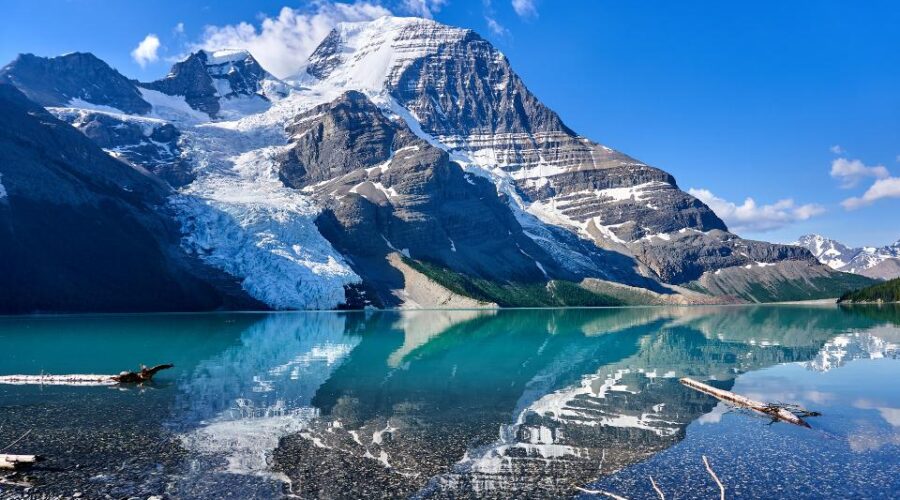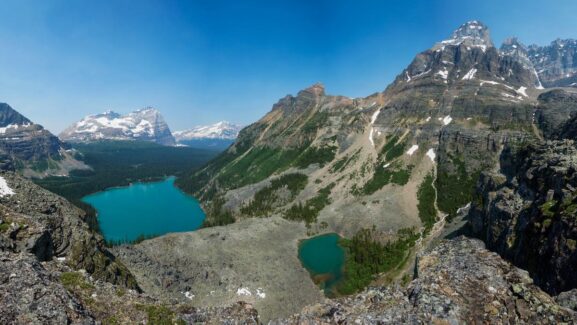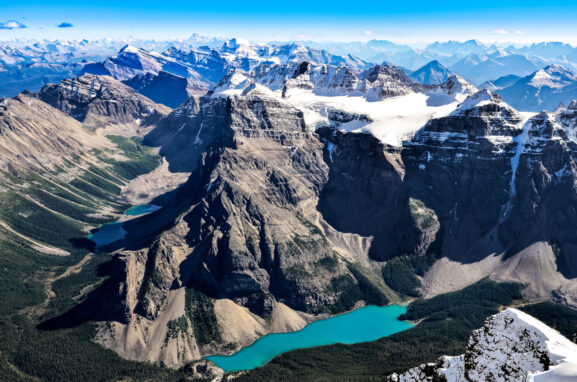10 Best Multi-Day Hikes In Banff And The Canadian Rockies
Ready to swap Wi-Fi for wildflowers? The Canadian Rockies are loaded with multi-day treks that take you deep into glacier country, alpine meadows, and some of the most unreal scenery on the planet.
Banff, Jasper, Yoho, and Kootenay National Parks each offer something different. Some hiking routes are chill and beginner-friendly, while others push you into full-on wilderness mode.
One of my favourite things about the Canadian Rockies is that 90% of tourists don’t go more than 20 minutes from a parking lot, so if you’re adventurous enough to get into the backcountry, you aren’t likely to find many crowds.
But if you really want to unplug and rewild yourself, there’s nothing better than planning a multi-day hiking trek and sleeping in a tent in the Rocky Mountain backcountry.
I wanted to create this guide to cover some of the best multi-day hikes and treks in Banff and the Canadian Rockies to help make backcountry hiking and camping a little bit easier for those just getting into this adventure sport.
In this guide, you’ll find trail statistics, highlights, difficulty and where you can camp on your multi-day hikes. So, get ready to pack your gear, book your campsites for summer and let’s get into it!
1. Mount Assiniboine
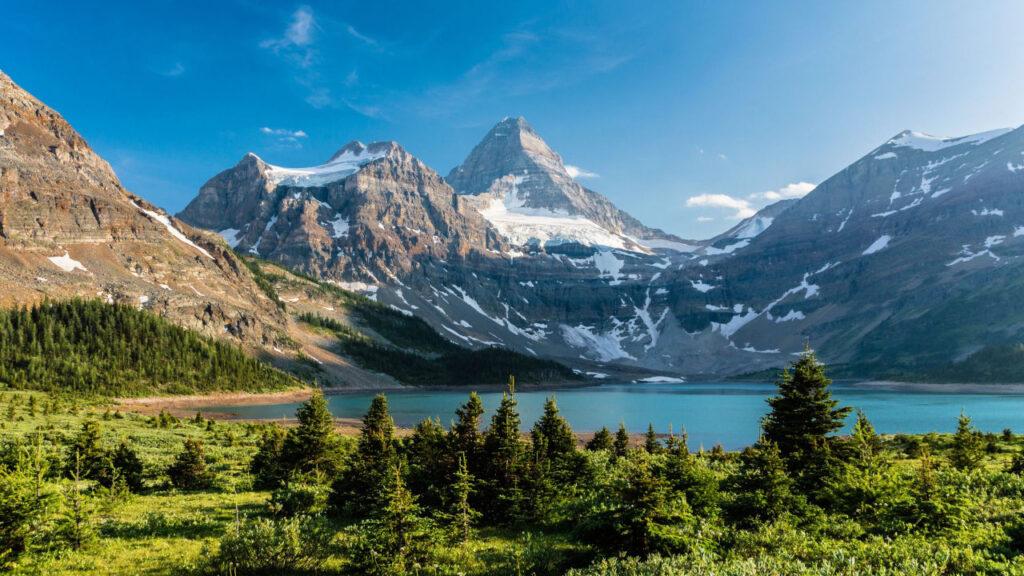
Location: Banff National Park and Mount Assiniboine Provincial Park
Distance: 55 km (varies by route)
Duration: 3–5 days
Elevation Gain: 1,200 m
Difficulty: Moderate to challenging
Camping: Lake Magog, Og Lake, Porcupine
This trek is a rite of passage for Canadian hikers. Starting at Sunshine Village (accessible via gondola or hike), you hike through alpine meadows, past crystal-clear lakes, and over high passes until the trail gradually reveals glimpses of the pyramid-shape wonder that is Mount Assiniboine.
Mount Assiniboine, sometimes referred to as the “Matterhorn of the Rockies” is the highest peak bordering Banff National Park at 3,618 m (11,870 feet). The best campsite is at Lake Magog just below the mountain.
You can hike back the way you came or exit via the tougher Marvel Lake and Bryant Creek route toward Mount Shark in Kananaskis Country. Some hikers opt for a scenic floatplane ride out from Assiniboine Lodge (if they’ve got the budget).
2. Skoki Loop
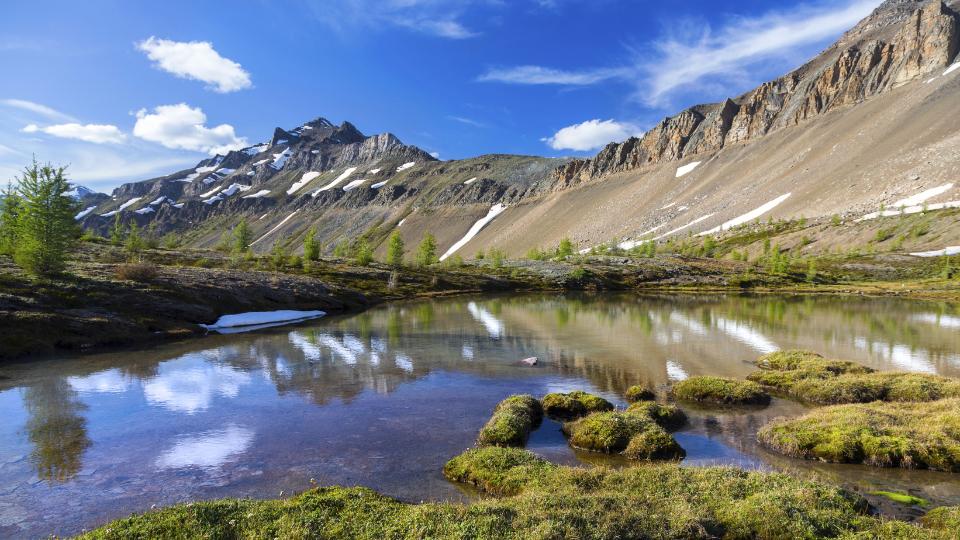
Location: Banff National Park
Distance: 34 km loop
Duration: 3–4 days
Elevation Gain: 850 m
Difficulty: Moderate
Camping: Baker Lake, Merlin Meadows
The Skoki Loop offers a perfect blend of alpine lakes, open meadows, and rugged passes with a quieter, more tucked-away feel than other Banff classics. It starts at the Fish Creek trailhead near Lake Louise Ski Resort and continues upward to Boulder Pass and Ptarmigan Lake.
From there, the trail dips into Skoki Valley, winding past Myosotis and Zigadenus Lakes before climbing over Deception Pass. You’ll get nonstop views, plus the bonus of the historic Skoki Lodge (if you feel like splurging on a rustic backcountry bed).
The Skoki Loop is ideal for hikers looking for a 3–4 day adventure with fewer people and plenty of mountain eye candy. The trail loops back via Packers Pass, giving you a different perspective on the return. Just watch for grizzlies because this is prime bear country, so make sure you travel in a group and pack your bear spray.
3. Egypt Lake Loop
Location: Banff National Park
Distance: 40–50 km (loop options)
Duration: 3–4 days
Elevation Gain: 900–1,200 m
Difficulty: Moderate
Camping: Egypt Lake, Pharaoh Creek, Twin Lakes
Egypt Lake is a stunning multi-day loop that showcases Banff’s alpine backcountry. Starting from Sunshine Village (or Vista Lake for a tougher climb), the trail climbs over Healy Pass, a wildflower-filled wonderland in July and August.
You’ll get sweeping views of the Monarch Ramparts and Pharaoh Peaks as you make your way toward Egypt Lake. The lake itself is serene and surrounded by dramatic cliffs and forest. There’s a well-established campground and some nearby side hikes, including Whistling Pass and Scarab Lake, which are absolutely worth exploring if you’ve got the legs.
If you’re doing a loop, many hikers continue toward Ball Pass or Twin Lakes and loop back to the highway. It’s a manageable 3- to 4-day trek that offers a little bit of everything: big views, cool side trails, and excellent camping spots.
4. Cascade Amphitheatre to Elk Lake
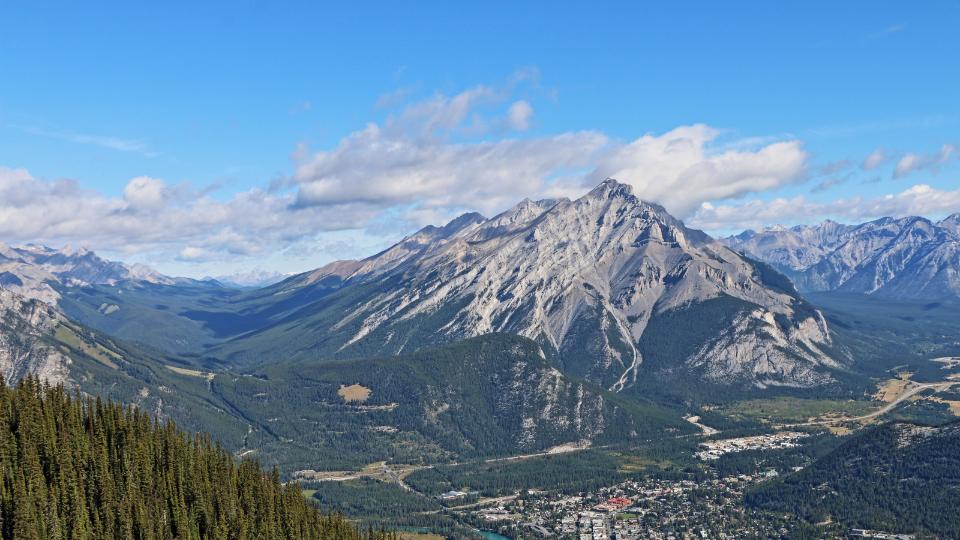
Location: Banff National Park
Distance: 35 km
Duration: 2–3 days
Elevation Gain: 1,000 m
Difficulty: Moderate to challenging
Camping: Elk Lake
This route is a bit of a hidden gem. Starting at the Mount Norquay parking lot, you hike up into the Cascade Amphitheatre, which is an epic bowl-shaped valley surrounded by dramatic cliffs and mountain walls. From there, it’s a wild backcountry route over Cascade Pass and into remote valleys with little foot traffic.
The reward is a quiet, rugged experience. Elk Lake and its backcountry campsite are peaceful, and the trail often feels like yours alone. You’ll pass unnamed lakes and streams, see wildlife tracks (and maybe the animals themselves), and soak up total silence and stillness of wild nature.
This trek is perfect if you’re looking to escape the crowds. It’s not flashy or Insta-famous, but it’s rich in solitude and deep nature immersion. You’ll need decent navigation skills and a love of the wild side.
5. Sawback Trail
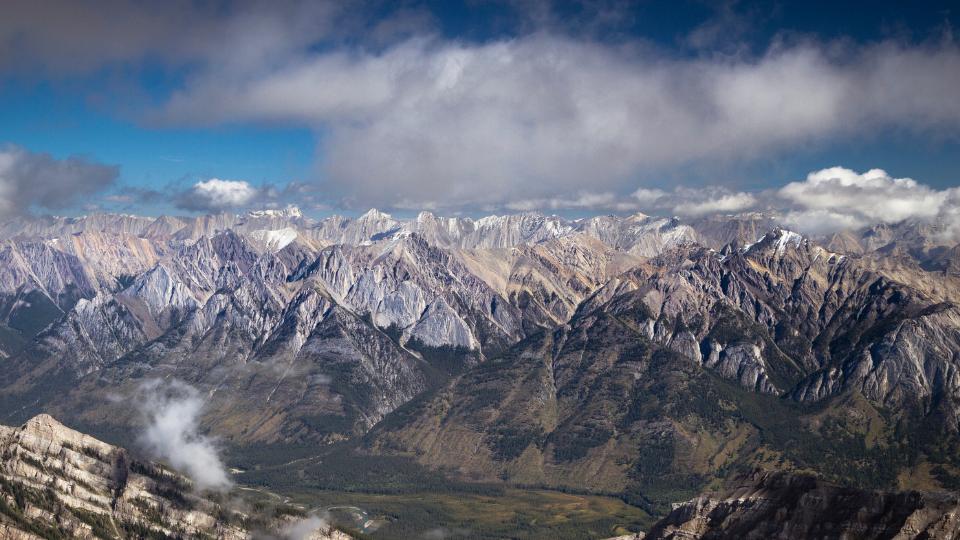
Location: Banff National Park
Distance: 70–90 km
Duration: 5–7 days
Elevation Gain: 2,500+ m total
Difficulty: Challenging
Camping: Mystic Valley, Pulsatilla, Wildflower
The Sawback Trail is one of the longest and most rewarding multi-day hikes in Banff. Stretching up to 90 km depending on your route, it runs from Mount Norquay all the way to the Lake Louise area, cutting through some of the park’s most remote terrain.
This hiking trail is a true backcountry journey. Expect multiple elevation gains, glacier views, and a sense of being deep in the wild. Some of the highlights include Mystic Pass, Pulsatilla Pass, and Badger Pass. The trail is well-maintained but long, so it’s best for hikers with solid endurance and a bit of experience managing backcountry logistics.
With 5–7 days on the trail, this trek gives you space to disconnect and drop into the rhythm of hiking, eating, and sleeping in nature. Wildlife sightings are common here, so keep an eye out for grizzlies, moose, and even wolves if you’re lucky.
6. Skyline Trail
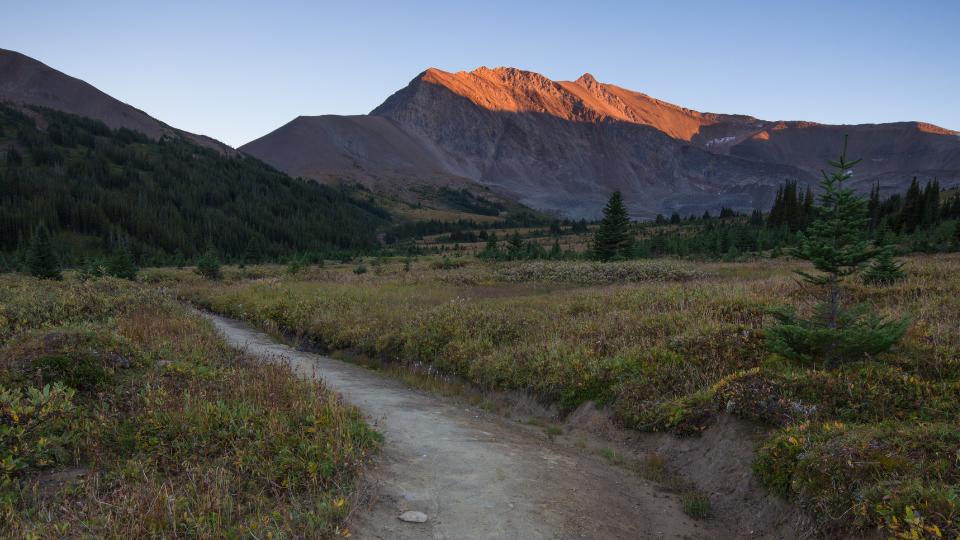
Location: Jasper National Park
Distance: 44 km (one-way)
Duration: 2–3 days
Elevation Gain: 1,200 m
Difficulty: Moderate
Camping: Snowbowl, Curator, Tekarra
The Skyline is Jasper’s signature multi-day hike and for good reason. About 25 of its 44 km are above the treeline, offering wide-open alpine views that just keep coming. Starting at Maligne Lake and finishing near Signal Mountain, it’s typically done over 2–3 days with backcountry campgrounds spaced out nicely along the way.
The high point is The Notch, a dramatic pass that gives you 360° views of ridges, valleys, and distant peaks. Wildflowers explode here in summer, and it’s common to spot marmots, mountain goats, and maybe even caribou if you’re lucky. The trail is well-marked, but weather changes fast up high so bring lots of layers and a healthy respect for mountain forecasts.
This trail gets popular during peak season, so book your campsites early. It’s a one-way hike, so you’ll need to arrange a shuttle or leave a vehicle at each end. If you’re after maximum views and minimal forest slog, this one’s hard to beat.
7. Berg Lake Trail
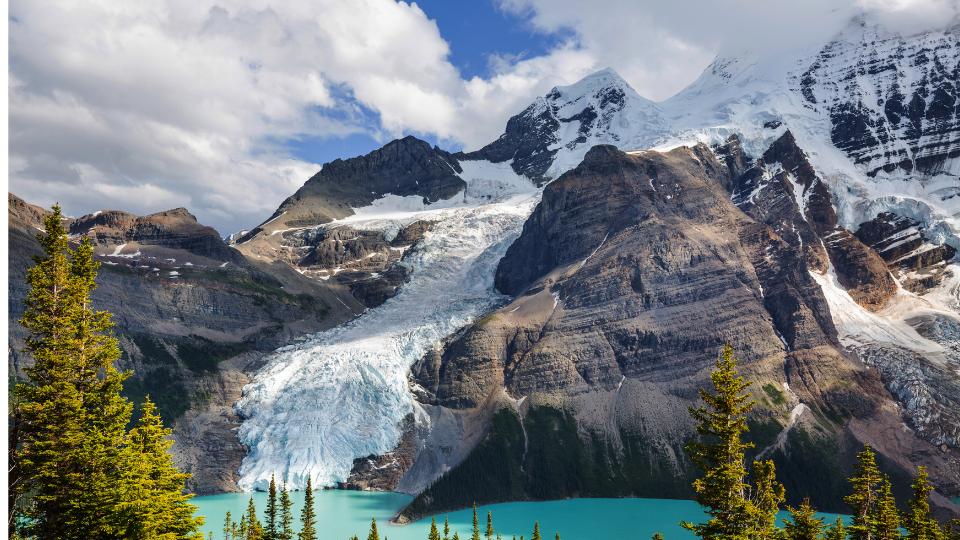
Location: Mount Robson Provincial Park (near Jasper)
Distance: 42 km round trip
Duration: 2–4 days
Elevation Gain: 800 m
Difficulty: Moderate
Camping: Emperor Falls, Marmot, Berg Lake
This trail is legendary. Starting near 3,959 m (12,989 feet) Mount Robson, the tallest peak in the Canadian Rockies, it climbs 21 km to the turquoise-blue Berg Lake backdropped by a glacier pouring right into the water. Most hikers do it over 2–4 days, camping at Emperor Falls, Marmot, or Berg Lake campgrounds.
The trail passes through multiple ecosystems, starting in cedar rainforest and ending in a stark alpine world. Highlights include waterfalls (White Falls, Emperor Falls), the Valley of a Thousand Falls, and watching chunks of the glacier calve into the lake. It’s dramatic, humbling, and surprisingly accessible for something this epic.
The area was closed for repairs for the last couple of years but reopened recently with a new permit system. Book early, train those legs and prepare yourself for one of those hikes that stays with you for life.
8. Rockwall Trail
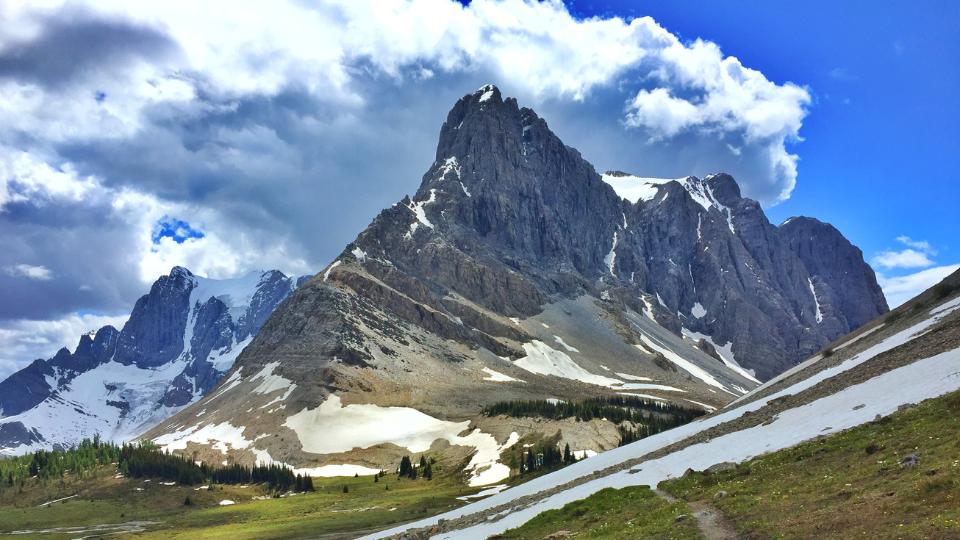
Location: Kootenay National Park
Distance: 55 km
Duration: 4–5 days
Elevation Gain: 2,600 m total
Difficulty: Challenging
Camping: Helmet Falls, Tumbling Creek, Floe Lake
A jaw-dropper of a trek, the Rockwall Trail runs 55 km along the base of a massive limestone cliff that stretches for miles. It’s usually done in 4–5 days with campsites like Helmet Falls, Tumbling Creek, and Floe Lake along the way. Each day brings new alpine passes, waterfalls, and views that feel straight out of a Patagonia catalogue.
You’ll start at either Paint Pots or Floe Lake trailhead, depending on your direction. Floe Lake is arguably the crown jewel, sitting in a bowl beneath towering cliffs and a hanging glacier. This hiking trail is well-graded but requires decent endurance, especially over passes like Numa and Tumbling.
The Rockwall Trail is perfect for backpackers who want challenge and beauty, without the crowds of Banff National Park. Bear spray is a must, and you’ll need to book campsites in advance. If you’re chasing that mix of wild terrain and epic views, Rockwall delivers in spades.
9. Iceline Trail + Little Yoho Loop
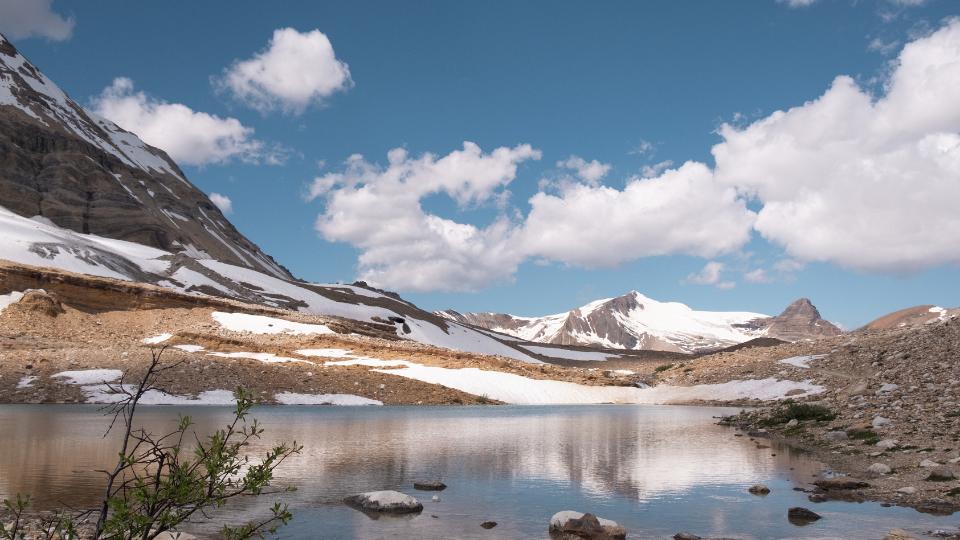
Location: Yoho National Park
Distance: 20–30 km (loop options)
Duration: 2–3 days
Elevation Gain: 800–1,000 m
Difficulty: Moderate
Camping: Little Yoho, Stanley Mitchell Hut
The Iceline Trail is a must-do for glacier lovers, and it can be turned into a fantastic 2–3 day backpacking loop with a stay at Little Yoho campground or the Alpine Club’s Stanley Mitchell Hut. Starting near Takakkaw Falls, it climbs fast into the alpine and hugs the toe of glaciers with sweeping views the whole way.
The highlight is hiking alongside moraine and glacier melt streams with Emerald Glacier right above you. You’ll pass tarns, waterfalls, and see Takakkaw Falls from above, which is a rare perspective that few tourists see. The Little Yoho Valley is lush and quiet, and offers optional side trips like Twin Falls or Kiwetinok Pass if you’ve got gas left in the tank.
This loop is short but packed with variety. It’s a great intro to backcountry hiking or a relaxed overnight for seasoned hikers who want max scenery with less grind. Just watch for snow early in the season as it’s a high-elevation trail.
10. Tonquin Valley
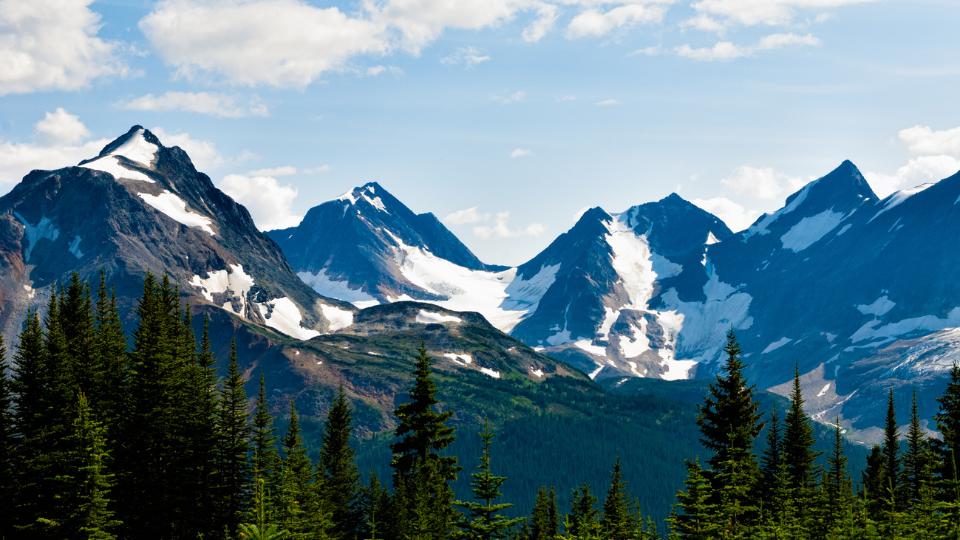
Location: Jasper National Park
Distance: 45–50 km
Duration: 3–5 days
Elevation Gain: 700–1,000 m
Difficulty: Moderate
Camping: Amethyst Lake, Surprise Point, Clitheroe
The Tonquin Valley is remote, rugged, and loaded with big-mountain energy. Spanning about 45–50 km, this 3–5 day trek winds through valleys beneath the dramatic Ramparts, a serrated wall of peaks that feels like something from a fantasy novel.
The big payoff is Amethyst Lake, which sits below the Ramparts and reflects their jagged peaks like a mirror. The area is rich in wildlife, so you’re likely to see grizzlies, caribou, moose, and all kinds of birds. It can be buggy mid-summer, but the fall colours here are unreal if you hit it in late August or September.
It’s less trafficked than the Skyline or Berg Lake, and the terrain is wilder. Be prepared for muddy sections and weather that shifts fast. But if you’re craving solitude and big landscapes, the Tonquin Valley will hit you right in the soul.
Bonus: The Great Divide Trail Through The Canadian Rockies
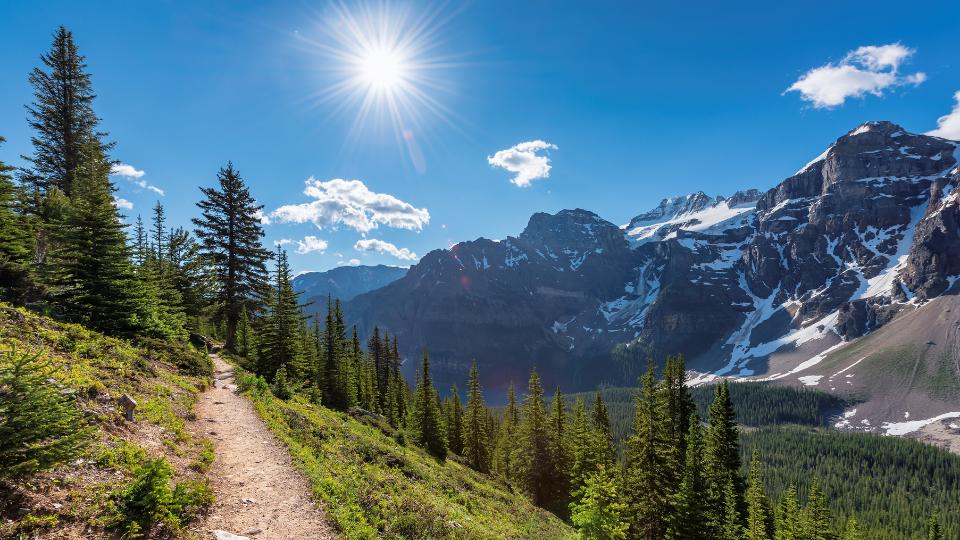
Distance: 1,130 km (split into 6 sections)
Duration: 6–8 weeks (or section hikes from 3–7 days)
Elevation Gain: 30,000+ m
Difficulty: Very challenging
Camping: Wilderness sites, random camping, designated sites
The Great Divide Trail is the ultimate trek in the Canadian Rockies. It’s not just a hike, it’s a full-on journey through the spine of the Canadian Rockies, hugging the Continental Divide from the U.S. border at Waterton Lakes to Kakwa Provincial Park in northern British Columbia.
At over 1,130 km, this is the longest and wildest trail on the list by far. It cuts through six national and provincial parks, plus a handful of wildland areas and forgotten valleys that see few people. The mountain scenery changes constantly as you hike past ancient glaciers, jagged ridgelines, high alpine passes, old-growth forest, and vast, empty valleys.
The trail is unofficial in parts. That means you’ll be route-finding, bushwhacking, and sometimes hiking faint game trails. Navigation skills are a must, and this is obviously not a trail for beginners or even intermediate hikers. Some sections are remote enough that you might go a few days without seeing another person.
That said, the rewards are unreal. You’ll see the Canadian Rockies at their most raw before the tour buses and gift shops of mass tourism. You’ll cross passes with no names, camp by lakes with no cell signal, and wake up to sunrises on epic mountain ridges with nothing but peaks in every direction.
Most people take 6–8 weeks to thru-hike the entire Great Divide Trail, but you can also section-hike it. Some of the most popular segments include the High Rock Trail, the stretch through Assiniboine, and the Yoho–Jasper sections. These can be done in 3–7 day chunks and still give you that big wilderness experience.
Backcountry camping is a mix of designated sites in parks and random camping in more remote zones. You’ll need a detailed resupply plan or do a few food drops. Some sections even require an ice axe and microspikes in the early season. It’s a serious backcountry adventure that you will never forget.
The Great Divide Trail is for expert hikers who want solitude, challenge and deep connection with nature. If you’ve done all the other trails on this list and you’re ready to level up, then this is it!
- 10 Best Multi-Day Hikes In Banff And The Canadian Rockies - April 18, 2025
- The 10 Best Hikes At Lake O’Hara In Yoho National Park - April 18, 2025
- The 10 Best Hikes In Banff National Park For Summit Views - April 18, 2025

